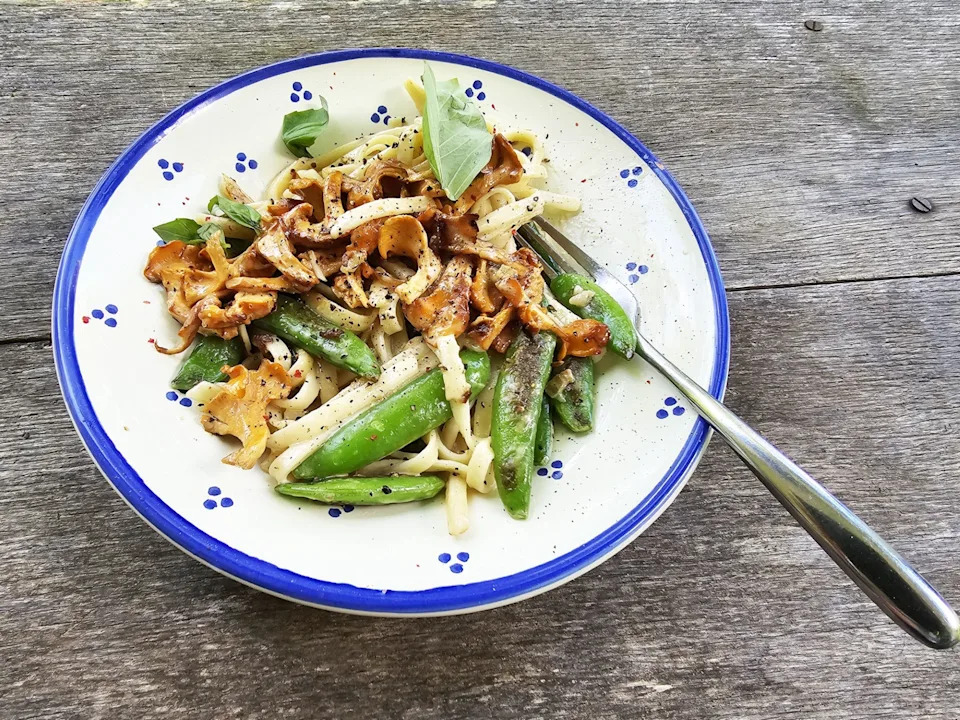It’s been a few months (April, to be exact) since I took you foraging for mushrooms. In the spring season we were alert for morels, brown, wrinkly, and almost hidden in the left-over leaves of winter. Now, in the height of summer, we are on the lookout for chanterelles, orangey-gold, shaped like the bell of a trumpet, exuding an unmistakable fragrance of apricots.
Unlike the elusive morel, chanterelles jump out at you when you meet them in the woods, usually scattered on old sledroads, under oaks and hickories, but also near hemlocks and various fir trees.
Chanterelle is the common name of several species of fungi across varying genera, including Cantharellus, Craterellus, Gomphus, and Polyozellus. On the underside of the cap, most of them have rounded, forked folds that run almost all the way down the stipe, which tapers down from the cap. They are relatively small (dime-sized to fist-sized in our woods), meaty, slightly peppery, and as before-mentioned, definitely apricoty.
Beware of the jack-o-lantern mushroom, Omphalotus illudens, which—unlike the chanterelle—does not grow directly on the ground, but rather flourishes at the base of trees. A bioluminescent species, the jack-o-lantern is often larger in size than the chanterelle, and does not have the scent of apricots.
When you do run across a flush of chanterelles, be sure to trim and brush them clean as you gather them, so that bits of leaves and dirt won’t stick to the flesh as it dries. I like to forage with a knife and a brush—or better yet, a knife with a brush attached at the opposite end, made especially for this purpose—and lay them in a basket, on top of a newspaper or dish towel to keep them fresh and dry.
If you don’t have woods for your backdrop, many supermarkets now carry a variety of mushrooms when the season is right, although the price might make you hesitate to try more than a few. And if you don’t find chanterelles at all, and want to try some other species, by all means substitute as you see fit.
There are many things you can do with these golden treasures of the forest. You can toss them into an omelette for breakfast (after sautéing in butter); you can serve them up with a hearty steak; you can cook them in a cream sauce and spoon over a poached chicken breast; you can mince them up and sauté with shallots, and serve on top of a slice of baguette, bruschetta style; you can fry them up with apricots and serve on top of rice; or you can try the recipe below:

Pasta with peas and golden chanterelles.
Pasta with Peas and Golden ChanterellesIngredients:
1 family-sized portion of pasta of choice
A few generous handfuls of snap peas
A dozen or more chanterelles
1 tablespoon butter for the chanterelles, plus some for the snap peas
1 tablespoon olive oil for the pasta
A palmful of salt for the pasta
Preparation:
Cook the pasta al dente in salted water (slightly firm to the tooth, but not chewy). While pasta water is boiling, sauté chanterelles in butter, after tearing them into bite-sized pieces. Simultaneously, sauté the snap peas — after removing strings — gently in butter, making sure they remain bright green. Dice a shallot (more subtle than garlic) and add some to the peas, and some to the chanterelles. Season with salt and pepper.
When the pasta is ready, drain and return to the pot, stirring in olive oil to keep it from sticking. Add some heavy cream in with the chanterelles, and let it bubble a bit until it thickens.
Dish up the pasta on warmed plates, top with the brilliant green snap peas, and then with the golden chanterelles. Sprinkle with a bit of parmesan and more black pepper if you wish. Add a few leaves of fresh basil. Serve some crusty bread on the side, and a glass of white wine if you are so-inclined, or a light red (Pinot noir would do nicely), or your favorite glass of iced tea, sweet or not.
Enjoy with family or friends, or all by yourself, knowing that you will have extra to heat up tomorrow. If you have eaten it all, you might just have to head back out to the woods again!

Susi Gott Séguret
Susi Gott Séguret, author, chef, fiddler, ballad singer, was born and raised in Madison County, where she holds frequent foraging-cooking-dining sessions known as the Appalachian Culinary Experience, as well as a variety of other culinary adventures, including French Farmhouse Dinners, and Wine in the Woods. For further details, visit www.quintessentialtable.com.
This article originally appeared on Asheville Citizen Times: Appalachian Ingenuity, Recipes of Comfort, Resilience: Golden goodness


Dining and Cooking